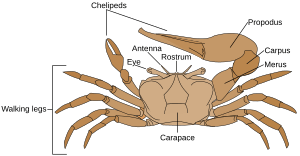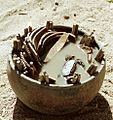Crab facts for kids
Quick facts for kids Demi |
|
|---|---|
 |
|
| Grey swimming crab Liocarcinus vernalis |
|
| Scientific classification |
|
| Kingdom: | Animalia |
| Phylum: | Arthropoda |
| Subphylum: | Crustacea |
| Class: | Malacostraca |
| Order: | Decapoda |
| Suborder: | Pleocyemata |
| Infraorder: | Brachyura Linnaeus, 1758 |
| Sections and subsections | |
|
|

Crabs are amazing creatures found in the subphylum Crustacea. They are part of a group called decapods, which means they have ten limbs. These include eight walking legs and two strong grasping claws. Other famous decapods are lobsters, crayfish, and shrimps. Crabs belong to a special order within decapods called Brachyura. Their bodies are short and covered by a very thick outer shell, known as an exoskeleton.
Crabs are super successful animals, living all over the world. They are like little armored tanks! Most crabs live in the ocean, but some can be found in fresh water, and a few even live entirely on land. The smallest crabs are as tiny as a pea, while the biggest, the Japanese spider crab, can have legs that spread out 4 meters wide! There are about 7,000 known species of crabs.
Contents
What Makes a Crab Unique?
Crab Body Features
Crabs have very short tails. Unlike other crustaceans, a crab's tail and its small abdomen are completely tucked away under its main body, or thorax. You usually can't see it unless you turn the crab over. Their very hard exoskeleton acts like a suit of armor, protecting them well from predators. Crabs are also known for their single pair of powerful claws. You can find crabs in all oceans, and some even live in fresh water or on land.
How Crabs Use Their Pincers
The pincers, also called claws, are a crab's most important tools and weapons. They have at least three main jobs. First, pincers help crabs grab and hold their prey when they eat. If their food is a shellfish, like a mollusc, the pincers can be strong enough to open or break its shell. Second, male crabs use their pincers for fighting each other. Third, crabs use their pincers to send signals to other crabs, like waving hello or warning them to stay away.
What Do Crabs Eat?
Crabs are omnivores, which means they eat almost anything they can find. They often munch on algae, but they also need animal food to stay healthy and grow. Their diet can include molluscs, other crustaceans, worms, fungi, and even tiny bacteria.
Crabs as Food Around the World
People all over the world prepare and eat crabs. Some types of crabs, like soft-shell crabs, are eaten whole, shell and all! For other species, only the claws or legs are eaten. In many places, special spices are added to make crab dishes even tastier. In Asia, dishes like Masala Crab and Chilli Crab are famous for their bold flavors. In Maryland, USA, blue crab is often enjoyed with a seasoning called Old Bay.
In Britain, a dish called Cromer crab involves taking the meat out and putting it back into the hard shell. In America, people often make "crab cakes" by mixing crab meat with flour. Crabs are also used to make bisque, a creamy French soup.
The History of Crabs
True crabs first appeared in the fossil record during the Lower Jurassic period. They were part of a big change called the 'Mesozoic marine revolution'. During this time, many new predators evolved on the sea floor.
Crabs vs. Crab-like Animals
The closest relatives of true crabs are a group of crustaceans called anomurans. This group includes animals like hermit crabs, king crabs, and squat lobsters. They often look a lot like crabs and even have "crab" in their names, but they are not true crabs. You can tell anomurans apart by counting their legs. True crabs have eight walking legs plus two claws. Anomurans, however, have their last pair of legs hidden inside their shell, so you can only see six walking legs.
Images for kids
-
Gecarcinus quadratus, a land crab from Central America
-
Crab (Pachygrapsus marmoratus) on Istrian coast, Adriatic Sea
-
Female crab Xantho poressa carrying eggs under her abdomen in the Black Sea
See also
 In Spanish: Brachyura para niños
In Spanish: Brachyura para niños








